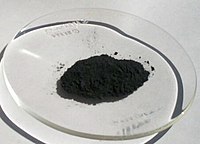
Photo from wikipedia
Abstract Efficient and low-cost water-gas shift (WGS) catalysts have aroused much attention for the purification of H2-rich syngas in the application of fuel cell. In this study, combustion of ethylene… Click to show full abstract
Abstract Efficient and low-cost water-gas shift (WGS) catalysts have aroused much attention for the purification of H2-rich syngas in the application of fuel cell. In this study, combustion of ethylene glycol and methanol (EGM), fractional precipitation (FP) and template growth (TG) methods have been utilized to synthesize copper-manganese oxide (CMO) catalysts. The prepared CMO catalysts are consisted of spinel Cu1.5Mn1.5O4 and Mn2O3 phases and exhibit porous, polyhedral nanoparticle and nanorod morphologies for EGM, FP and TG, respectively. The low-temperature WGS reaction activities of prepared catalysts follow the sequence: CMO-EGM > CMO-FP > CMO-TG, which are higher than that of CMO catalyst prepared by traditional co-precipitation method. Among them, CMO-EGM catalyst exhibits the highest reaction rate of 122.72 μmolCO g cat. − 1 s−1 at 200 °C, which is much higher than that of commercial Cu/ZnO/Al2O3 (73.62 μmolCO g cat. − 1 s−1). CO-TPSR and DRIFTS analysis reveal the superior activity of CMO-EGM is attributed to the larger amounts of active hydroxyl groups on the surface of catalysts, which correlate well with the high reducibility and abundant surface oxygen vacancies of CMO-EGM catalyst.
Journal Title: International Journal of Hydrogen Energy
Year Published: 2020
Link to full text (if available)
Share on Social Media: Sign Up to like & get
recommendations!